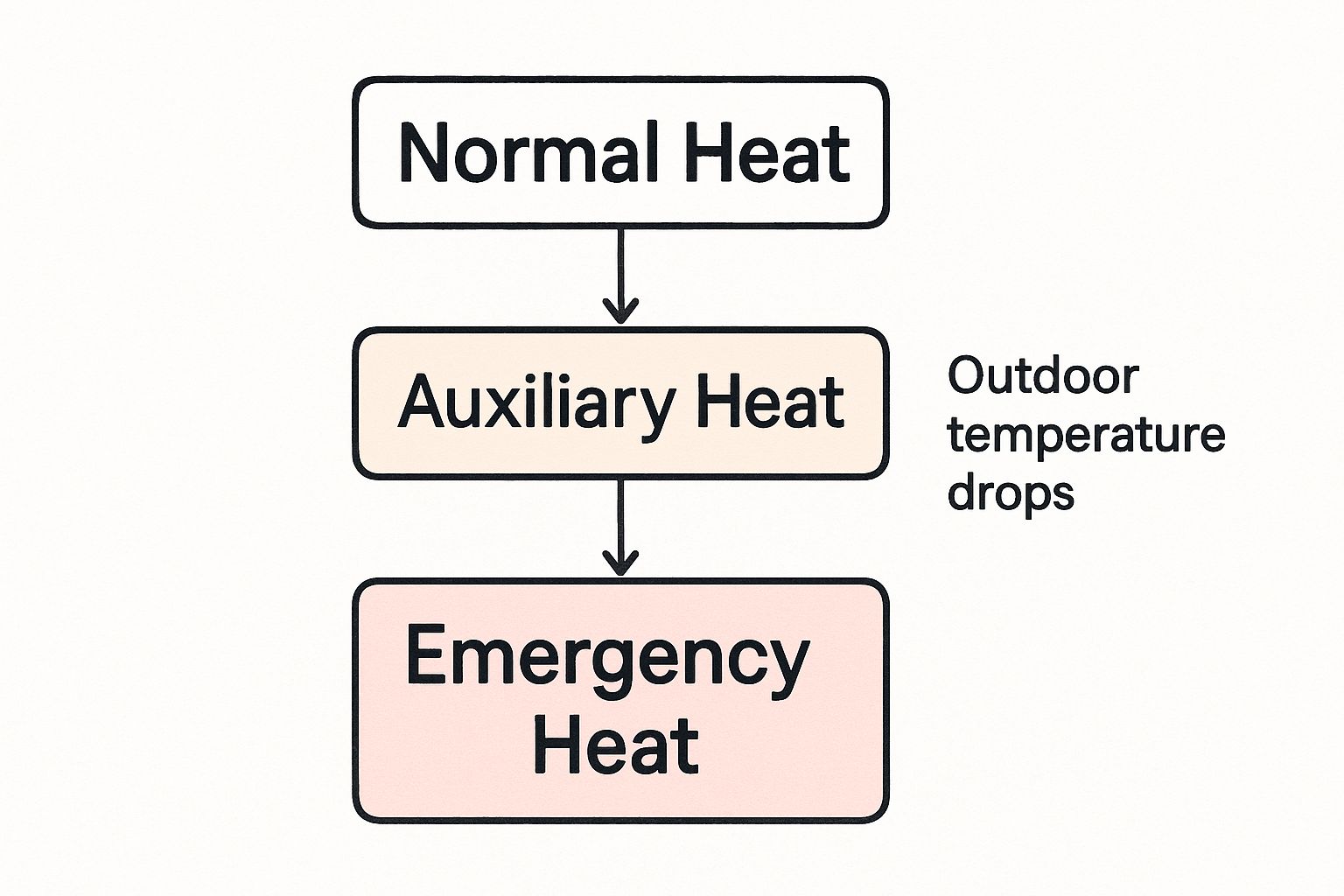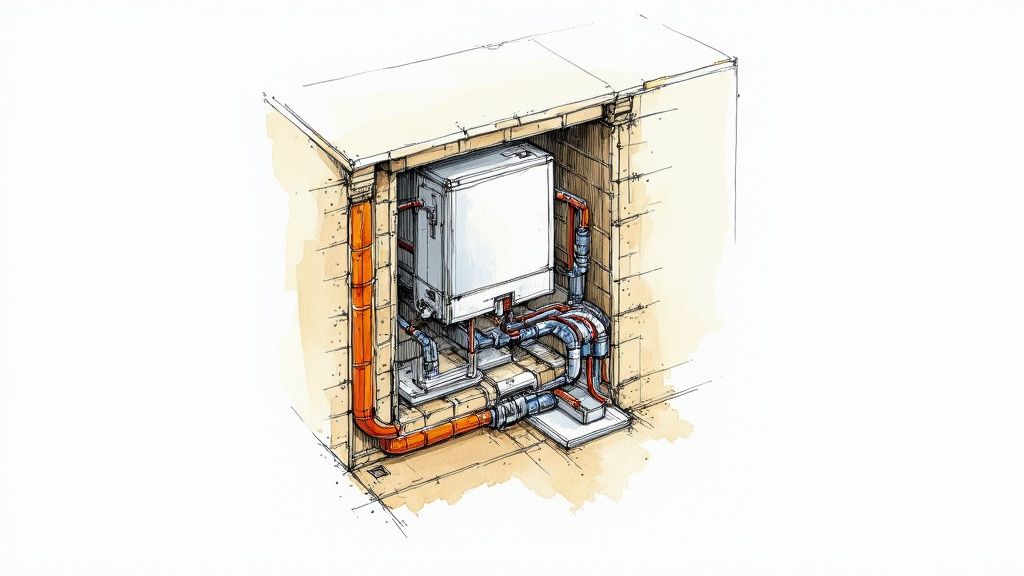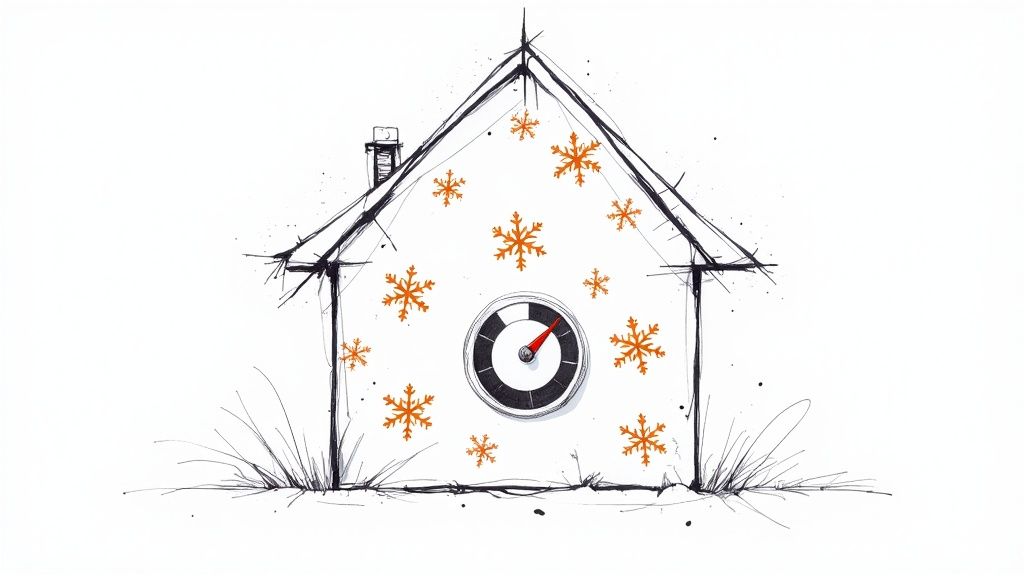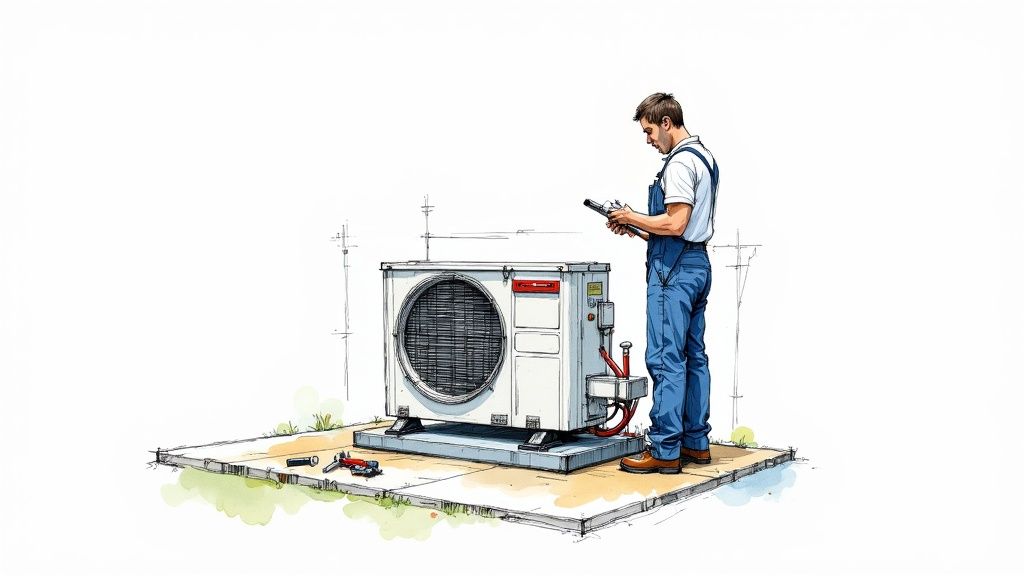You should only hit that emergency heat button in two very specific situations: when your outdoor unit has given up the ghost (think iced over or blowing cold air), or during those rare but biting cold snaps (usually below 30°F) where the system just can't keep up.
Think of it as a manual override—a temporary backup, not your go-to heating source.
Your Quick Guide to Using Emergency Heat
For a lot of homeowners around Kennesaw, Marietta, and the greater Atlanta area, that little "EM Heat" button on the thermostat is a total mystery. What does it do? When on earth are you supposed to use it?
Here’s a simple way to look at it. Your heat pump is like an incredibly efficient courier, grabbing heat from the outside air and moving it into your home. Emergency heat, on the other hand, is like firing up a powerful but expensive generator. It creates heat from scratch using electric resistance coils. It’s a lifesaver when you need it, but you definitely want to use it sparingly.
Understanding the different ways your system works is the key to keeping it running efficiently and avoiding those shocking winter energy bills. If you want a deeper dive into how these units work in the first place, there are some great guides comparing different heat pump systems.
Standard, Auxiliary, and Emergency Heat
Most of the confusion comes from mixing up when your system helps itself versus when you need to step in. Auxiliary heat is an automatic helper. Emergency heat is a manual override you control.
This image shows exactly how your system is designed to work as the temperature outside drops.

As you can see, your heat pump always tries to use its most efficient mode first. It only calls on the less efficient backups when conditions get tough. When you manually switch to emergency heat, you're forcing the system to skip the efficient steps and jump straight to the most expensive way to make heat.
That’s exactly why you should only use it when your primary heat pump has failed.
The energy difference is no joke. At 20°F, a heat pump might use 1.7 kWh of electricity in an hour. The emergency heat strips? They’ll burn through 4.9 kWh in that same hour—that's nearly three times the energy to get the same result.
To make things crystal clear, let's break down the key differences between your heat pump's modes.
Heat Pump Modes Explained
| Heating Mode | How It Works | When It Activates | Energy Efficiency |
|---|---|---|---|
| Normal Heat Pump | Pulls heat from the outside air and moves it into your home. | Your go-to mode during mild to moderately cold weather. | Very High |
| Auxiliary Heat | Electric resistance strips turn on to assist the heat pump. | Kicks in automatically for short bursts during defrost cycles or when the heat pump can't quite hit your thermostat setting on its own. | Low |
| Emergency Heat | Shuts down the outdoor unit completely and relies only on the electric resistance strips for heat. | You have to switch it on manually when your heat pump is broken or totally overwhelmed by extreme cold. | Very Low |
Basically, Normal and Auxiliary modes work together automatically to keep you comfortable as efficiently as possible. Emergency Heat is the "break glass in case of emergency" option you control when the main system is down for the count.
What Emergency Heat Actually Does
Before you can know when to use your heat pump's emergency heat setting, you need to understand what it actually does. It's not a "turbo boost" for your heater—it's a completely separate system.
Think of it like this: your high-efficiency heat pump is your everyday commuter car. It's smart, sips energy, and gets you where you need to go reliably. In this analogy, emergency heat is like a powerful, gas-guzzling truck you keep parked. You’d only fire it up for a very specific, heavy-duty job, and never for your daily drive.
When you flip that "EM Heat" switch on your thermostat, you’re making a manual override. Your system completely shuts down the outdoor heat pump unit—the part that cleverly pulls heat from the outside air to warm your home.

Activating the Electric Heat Strips
So where's the heat coming from if the main unit is off? That switch activates a set of electric resistance heat strips tucked away inside your indoor air handler.
These strips work exactly like the glowing coils in a toaster or a portable space heater. Electricity runs through them, they heat up, and your blower fan pushes that heat through your vents. It’s a brute-force method of creating warmth, and it’s incredibly power-hungry.
Key Takeaway: Emergency heat doesn't help your heat pump. It turns the heat pump off entirely and switches to a backup electric furnace. This is why it’s a last resort, not a performance booster.
Why It's a Backup System
This whole mechanism is designed as a fallback for only a couple of very specific situations. For homeowners in places like Canton or Marietta, your heat pump is more than capable of handling our typical winter weather.
The emergency heat function exists purely for two scenarios:
- A System Malfunction: If your heat pump breaks down, freezes over, or is otherwise out of commission, this backup ensures your family stays warm while you wait for a technician.
- Extreme, Prolonged Cold: During a rare, severe cold snap where temperatures plummet so low there isn't enough warmth in the outside air for the heat pump to work with.
That's it. Using emergency heat when your main system is working fine is like choosing to drive that heavy-duty truck on your daily commute. Sure, it gets the job done, but the cost at the pump is going to be painful. It's a critical safety net, but one you only want to use when you truly have to.
When Should You Switch to Emergency Heat?
Knowing when to flip the switch to emergency heat can be the difference between a warm, comfortable home and a shocking utility bill. For homeowners across the greater Atlanta area, from Marietta to Woodstock, there are really only two times you should ever have to manually turn on this powerful backup. Get it wrong, and you could be looking at a costly mistake.
The most important time to use emergency heat is when your primary heat pump gives out. Your system is built to be a workhorse, but like any machine, things can go wrong. The key is knowing what to look for so you can act fast.

Signs of a Heat Pump Malfunction
If the outdoor unit stops working, it can no longer pull heat from the air. When that happens, your indoor unit is just circulating cool air through your home. If you notice any of these red flags, it’s time to switch to emergency heat right away:
- The Outdoor Unit Is a Block of Ice: A light dusting of frost is perfectly normal and something your unit's defrost cycle can handle. But if it's encased in a thick layer of ice, the system can't "breathe" to transfer heat.
- Your Vents Are Blowing Cold Air: If you've got the thermostat set to "Heat" but the air coming out feels chilly or just room temperature, your heat pump has likely failed.
- You Hear Loud, Bizarre Noises: Any grinding, squealing, or banging sounds coming from the outdoor unit are a bad sign. It often points to a serious mechanical failure with the compressor or fan motor.
If you run into any of these problems, turn on the emergency heat to keep your house from getting dangerously cold. Then, your very next call should be to a professional technician from Top Tech Mechanical. Think of this setting as a temporary lifeline to keep your pipes from freezing while you wait for an expert to diagnose and fix the real issue.
During an Extreme Cold Snap
The second, and much less common, reason to use emergency heat is during a severe cold snap. Heat pumps are incredibly efficient because they move heat, not create it. But when the temperature outside plummets, there’s simply not much heat left in the air for them to grab.
Most modern heat pumps work just fine down to about 30°F. Below that, their efficiency starts to drop.
When It's Just Too Cold: If the forecast for your area—whether you're in Acworth or Roswell—calls for temperatures to stay below 25°F for a long stretch, your heat pump is going to struggle. Manually switching to emergency heat can give you the consistent warmth you need until things thaw out.
Of course, every system is different, depending on its age and model. A good rule of thumb is this: if your home just won't get warm and you notice the heat pump running nonstop, it's being pushed past its limit. Using emergency heat in that scenario is the right call.
The best defense against winter weather is making sure your system is ready for it. Regular maintenance goes a long way. You can learn more about getting your system prepared by reading our guide on winter preparedness and heating efficiency.
In either case—a breakdown or a bitter cold spell—emergency heat is only a short-term solution. It's there to provide critical warmth until your main system is back up and running properly.
Understanding Auxiliary Heat vs. Emergency Heat
One of the most common points of confusion for homeowners with a heat pump is the difference between "auxiliary heat" and "emergency heat." They both use the same electric heat strips inside your system, but they operate in completely different ways. Getting them mixed up is a surefire way to get a shockingly high energy bill.
Auxiliary Heat is Your System's Automatic Helper
Think of your heat pump like the main engine in your car and auxiliary heat as a turbocharger.
The auxiliary heat is that automatic turbo boost. You don't control it. It just kicks on for short bursts when your heat pump needs a little extra power to get the job done, then it shuts back off. It assists your main system, it doesn't replace it.
Your heat pump will automatically call on this "turbo boost" in a couple of key situations:
- During a defrost cycle: When the outdoor unit needs to melt ice, it briefly reverses itself. The auxiliary heat turns on to keep warm air flowing through your vents so you don't get a blast of cold air inside.
- To catch up quickly: If you bump the thermostat up by more than a few degrees, the auxiliary heat will help your system reach that new, warmer temperature much faster.
Emergency Heat is a Full Manual Takeover
Now, emergency heat is a totally different story. When you flip that switch on your thermostat, you are manually telling your primary system—the heat pump—to shut down entirely.
From that moment on, your home is relying 100% on those far less efficient electric resistance strips to generate heat. You've essentially parked your main engine and are now trying to power your whole home with a much smaller, gas-guzzling backup.
This is the most important distinction. Auxiliary heat is an automated, temporary assistant. Emergency heat is a manual override you should only use when your main system is completely out of commission.
The core difference comes down to control. Auxiliary heat is an automatic helper that works alongside your heat pump for peak performance. Emergency heat is a manual panic button that forces your system to use its most expensive heating method.
Understanding this helps you trust your system to do its job automatically without rushing to flip the expensive emergency switch. When temperatures really plunge, it's normal for your heat pump to need this supplemental boost, since there's less heat to pull from the frigid outside air. It’s also there as a failsafe if your heat pump malfunctions. For a deeper dive, the International Energy Agency has a great report on the future of this technology and its role in global heating solutions.
The Real Cost of Using Emergency Heat
While that "EM Heat" setting is a critical safety net when your system fails or it's bitterly cold outside, it comes with a pretty shocking price tag. Understanding why it's so expensive helps homeowners in places like Smyrna and Marietta see it for what it is: a true last resort, not a performance booster.
The difference in cost really boils down to one simple idea: moving heat versus making it from scratch.
Your heat pump is an efficiency champion because it moves existing heat from the outdoor air right into your home. This process is incredibly effective and sips a relatively small amount of electricity. Emergency heat, on the other hand, fires up electric resistance strips that create heat from raw electricity—think of it like a giant, powerful toaster inside your air handler. This brute-force method is far less efficient and absolutely devours power.
Why Your Electric Bill Spikes
When you flip that switch to emergency heat, you’re completely bypassing your efficient primary system for a power-hungry backup. The impact on your energy consumption is immediate and direct.
Using emergency heat can be 2 to 5 times more expensive than running your heat pump normally. Just a few days of relying on this setting can easily tack on hundreds of dollars to your utility bill.
This dramatic cost increase is exactly why you can't run on emergency heat for long without breaking the budget. And while it’s sometimes necessary, adopting broader energy efficiency tips to save money on your bills can help you manage overall household expenses and soften the blow during winter.
A Warning Sign for Your System
If you find yourself needing to use the emergency heat setting often, take it as a clear warning sign. Your HVAC system is trying to tell you it needs professional attention.
A properly functioning heat pump should be able to handle the vast majority of our Georgia winters without you ever needing to manually override it. If you’re constantly relying on the backup strips, it points to an underlying problem that’s not only costing you a fortune but also putting serious strain on your equipment.
To keep those budget-breaking costs at bay, preventative care is your best investment. Scheduling regular heating maintenance with Top Tech Mechanical ensures your heat pump runs at peak efficiency all winter, keeping your home warm and your energy bills predictable.
Common Questions About Emergency Heat
Even after getting the basics down, you probably still have a few questions about your heat pump's emergency heat setting. It’s a feature that can be a real lifesaver, but it also causes a lot of confusion for homeowners around Kennesaw and Woodstock. Let's clear up some of the most common concerns.

How Long Can I Run My Heat Pump on Emergency Heat?
It helps to think of your emergency heat like the spare tire in your car. It’s not meant for a long road trip; it’s there to get you safely to the mechanic.
You should only run the emergency heat for the absolute shortest time possible. The goal is to keep your home from freezing just until a professional HVAC technician can get there to fix the real problem. Whether it's AC repair in the summer or heating installation in the winter, timely service is key. While emergency heat can definitely keep you warm for a day or two in a pinch, leaving it on any longer will lead to a shockingly high electric bill.
If a breakdown forces you to use it for more than 24 hours, you need to schedule a service call right away.
Does My Thermostat Show When Emergency Heat Is On?
Yes, just about any modern digital thermostat will give you a clear signal when the backup heat is running. The exact display will depend on your model, but you’ll usually see one of two things:
- "EM" or "EM Ht": This indicator typically shows up only when you’ve manually flipped the switch to the emergency setting. It’s your thermostat’s way of confirming that the heat pump is off and only the electric heat strips are firing up.
- "AUX" or "AUX Ht": This light tells you the system is automatically using the auxiliary heat strips to help the heat pump. It's completely normal to see this pop on and off when it's extremely cold outside or during a defrost cycle.
If you notice the "AUX" light is on all the time, even when it’s not that cold, it’s a red flag. That could mean your heat pump is struggling and needs a professional check-up.
Is It Bad to Manually Turn On Emergency Heat?
It isn't bad for your HVAC system, but it's definitely bad for your wallet. That switch is there for a reason—a true emergency. Think of a complete system failure or one of those rare Georgia cold snaps where your heat pump just can't keep up.
Flipping it on manually when your heat pump is working fine is just an incredibly inefficient and expensive way to heat your house. Your best bet is to always leave the system in its normal "Heat" mode and let it manage the auxiliary function on its own. Trust it to do its job.
What If My Heat Pump Seems Stuck on Emergency Heat?
If you notice your system is constantly running on backup heat, especially on a mild day, you've got a problem. The very first thing to do is check your thermostat. It’s possible someone in the house accidentally switched it to the "EM Heat" setting.
If the thermostat is on the regular "Heat" setting but the backup strips are still running (you’ll know from a constant "AUX" light and lukewarm air), you’re likely dealing with a bigger issue. Common culprits are refrigerant leaks, a failing compressor, or a bad defrost control board. A system stuck like this can also be the reason your HVAC system is blowing warm air when it shouldn't be.
This is a situation that needs an immediate diagnosis from a certified technician to stop a sky-high energy bill and prevent more damage.
Don't let a malfunctioning heat pump leave you in the cold. If you're experiencing issues or have more questions about your system, the expert technicians at Top Tech Mechanical are here to help. From commercial AC services in Atlanta to residential heating repair in Powder Springs, we ensure your home or business stays comfortable and efficient all winter long. Contact us today at https://toptechmech.com to schedule your service.
